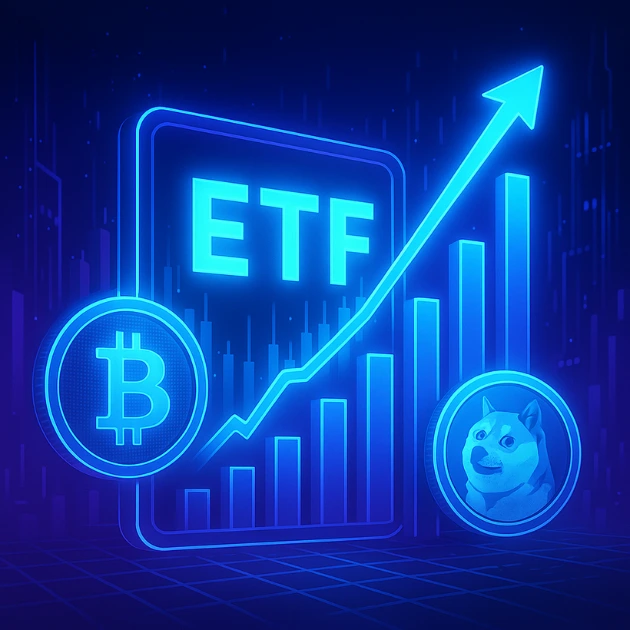The crypto landscape continues to grow in the midst of what is being dubbed the “Summer of Crypto”. With the introduction of Bitcoin exchange-traded funds (ETFs), barriers to crypto investment have been lowered to such a level that the average investor feels like it is a possibility.
In an important piece of crypto news, the Securities and Exchange Commission could – as soon as late September – give official approval for new listing standards for crypto- and commodity-based ETFs. This will ultimately pave the way for a litany of new offerings that the cryptocurrency industry has been more than eager to see introduced.
Regulatory Machinations
There are several regulatory gears moving at the moment. Some of them are more critical than others and could lead to the approval of a plethora of ETF fund approvals based on the XRP and Solana cryptocurrencies. For those tokens, there are already regulatory processes underway.
Amidst a number of regulatory filings, all of which illuminate the range of products that may be soon available to investors, speculation remains. Though XRP- and Solana-based funds are the headliners, there is speculation that Trump Coin, DOGE Coin, and more obscure coins could join the list before long.
New Rules a Win for Crypto
The Nasdaq, NYSE Arca, and CBOE BZX Exchange have all proposed what are being called generic listing standards as they relate to commodities as well as any crypto-based exchange-traded products. This proposal goes back to the end of July.
The proposal from each of these three exchanges would ultimately allow certain funds based on a handful of coins to be approved in exactly the same way that regular ETFs are governed according to the 1940 Act. Things are a bit different for crypto ETFs at the moment. Crypto ETFS, which include spot Bitcoin funds, undergo a much lengthier approval process. This requires far more paperwork – 19b-4 applications – when it comes to requesting permission from the SEC to launch potential digital asset ETFs.
ETFs, traditional factors have largely kept new digital asset funds from popping up. The first Bitcoin ETF launch was actually initiated by the Winklevoss Twins back in 2013. It took more than a decade to come to fruition, and now other approvals seem to be following suit.
The implementation of these new rules, seen as generic listing standards, would be seen as a major win for the crypto marketplace. This would give ETF shops greater ability to add more coins into what has become a popular investment vehicle. That said, it would fall short of providing a more crypto-specific framework that would ultimately provide clearer insight as to what coins would be allowed by the SEC based on things like size or utility.
Grayscale Approval
As DOGE Coin aims to join the list of approved exchange-traded funds, there may have been an important pathway paved by Greyscale. Greyscale’s Bitcoin ETF has shown how viable crypto-based ETFs can be while showing the potential for greater institutionalisation for cryptocurrency.
In terms of meme coins, DOGE Coin has become something of the standard. With the growth of ETFs, those interested in the meme coin market shift their gaze to DOGE Coin. Shiba Inu’s (SHIB) volatility of late, not to mention greater SEC regulatory scepticism, remains the largest challenge.
The largest question is, “Would investors go for a DOGE ETF, or would they wait for some sort of more stabilised SEC framework? Shiba Inu’s performance so far in Q3 2025 has been a major red flag for other meme coins. It has experienced a 42.2% drop in terms of its year-to-date price, not to mention a 19.09% monthly decline.
The fall of Shiba Inu proposes the greater fragility of digital assets that have largely been built on speculative hype. Strategic accumulation remains, as is the case with the 3 trillion SHIB transfer from Coinbase to a cold wallet. If anything, it further underscores the potential risks of concentrated ownership. A 300 billion SHIB dump caused prices to drop 18% in August, making it clear that meme coins can suffer when whale-driven corrections arise.
That level of volatility has had an indirect impact on DOGE’s profile. Its market cap is just shy of $33 billion, and its daily transaction volumes are just shy of $2 billion. DOGE has managed to buck the norm and show stronger institutional adoption compared to other meme coins.
Tesla is a major driver in DOGE’s adoption. AMC has also integrated the token as part of its loyalty rewards programme, showing that DOGE possesses some real-world utility. On-chain metrics for DOGE suggest potential institutional inflows and whale accumulation.
SEC’s Approach to Meme Coins
Perhaps the biggest hurdle for DOGE is the SEC’s predominantly cautious approach when it comes to meme coin ETFs. The approval of Greyscale’s Bitcoin ETF is definitely a good precedent to be set; the SEC has also delayed its decisions on DOGE and similar altcoin ETFs until at least October 2025.
The two main concerns on the part of the SEC are about investor protection and liquidity. Mem coins like the aforementioned SHIB, citing fragmented order books and declining TVL, show the massive risks that come with speculative trading and market manipulation.
Greyscale’s proposed DOGE ETF is also facing scrutiny over whether or not the token would qualify more as a commodity instead of a security. The SEC has a slew of recent lawsuits against exchanges over tokens like Solana and XRP, which could suggest a greater overall focus on token classification. Should DOGE be labelled as a security, it could lead to structural and legal adjustments for its ETF creation, further delaying a potential approval.
DOGE Seeking Institutional Adoption
In spite of these regulatory headwinds, there is steam behind the DOGE ETF narrative. The application from Greyscale, with backing by Coinbase Custody, helps to address potential institutional concerns about security and custody. Other competitors, like 21Shares and Bitwise, are also looking to get in on the market. This signals that there is growing confidence as it pertains to DOGE’s viability.
Technical indicators are also buoying market sentiment. There is the potential for a breakout as it relates to DOGE hitting the $0.2100 support level, not to mention its proximity to the 50-day EMA. Making a move above $0.2865 could even push the price closely to $0.3500 – a more than 67% gain over current levels.
Analysts remain optimistic about an ETF approval. Obtaining the approval could be attractive when it comes to garnering institutional and retail capital. Investors will continue to base their moves off regulatory timelines and their own personal risk tolerance.
A potential approval, by as early as 2026, could create quite the opportunity. That said, the October 2025 decision window for the SEC is a wild card. With a more flexible framework for altcoin ETFs, DOGE could see a push for real-world utility and institutional adoption that makes it a “safer” bet than major competitors like SHIB.

